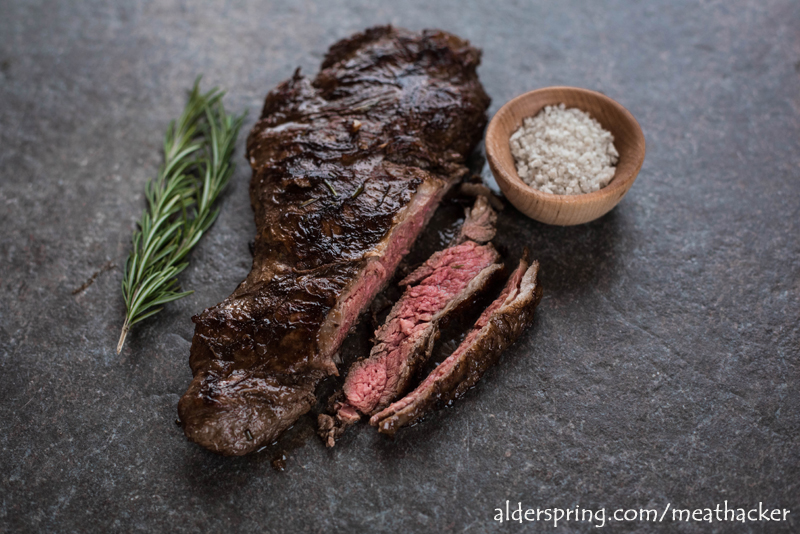The combination of balsamic vinegar and blackstrap molasses bring some earthy, elegant flavors to this steak marinade, and the three hour marinating time allows the steak to become extremely tender and juicy. This rich, Paleo steak can also be made winter or summer because it is cooked on the stovetop. The steaks you can use in this recipe aren’t as well-known as the Rib Eye or New York, but we think that they definitely should be. You’re missing out if you’ve never tried one of these thin, super flavorful cuts!
(Gluten Free, Grain Free, Paleo, Dairy Free, Egg Free, Soy Free, Nut Free, Refined Sugar Free)

Balsamic Skirt/Flap/Blade/Flank Steak Marinade
(Gluten Free, Grain Free, Paleo, Dairy Free, Egg Free, Soy Free, Nut Free, Refined Sugar Free)
This rich, Paleo steak can be made winter or summer because it is cooked on the stovetop. The combination of balsamic vinegar and blackstrap molasses bring some earthy, elegant flavors, and the three hour marinating time allows the steak to become extremely tender and juicy. The steaks you can use in this recipe aren’t as well-known as the Rib Eye or New York, but we think that they definitely should be. You’re missing out if you’ve never tried one of these thin, super flavorful cuts!
- 1 steak (skirt steak small or large, flank steak, flatiron, or flap)
- 2 tablespoons olive oil
- 2 teaspoon maple syrup
- 1 teaspoon oregano
- ½ teaspoon cilantro
- 1 teaspoon dried onion flakes
- ½ teaspoon sage
- 1 teaspoon rosemary
- Salt and pepper (sprinkled generously)
- 2 tablespoons black coffee (freshly brewed)
- ½ teaspoon molasses
- 1 teaspoon balsamic vinegar
- Put the steak into a medium sized bowl (preferably one that is wide and flat on the bottom, so that steak will be well-covered by marinade).
- Add all the marinade ingredients, then use your hands (yes, your hands) to rub the marinade into the steak and make sure that it’s well coated.
- Cover the bowl and put it in the refrigerator. Marinate for 3 hours or overnight. About 30 minutes before you are ready to make the steak, remove the bowl from the refrigerator and set it on the counter (this will allow the steak to warm to room temperature to ensure even cooking).
- Put about 2 tablespoons of olive oil in the bottom of a cast iron pan that is large enough to fit the steak with extra room on the sides. Depending on the size of your pan you may need more or less olive oil. Just make sure you add enough to cover the bottom of the pan well.
- Heat the pan to medium high heat. When the olive oil starts smoking slightly (the smoke will be barely visible, so you have to pay attention) put the steak into the pan. Keep as far away from the pan as you can as the hot oil might splatter.
- Allow the steak to cook for about three-four minutes on each side. Don’t move it around or mess with it with your spatula. If your burner doesn’t quite cover the bottom of your pan, you’ll want to move the pan (not the steak) around a little bit to make sure the steak cooks evenly.
- After about 3 minutes, check the bottom of the steak for brownness by lifting up an edge with your spatula. If it seems well-browned, flip. If it could get a little browner without burning, don’t flip it yet.
- Once you flip the steak, put a thermometer into the very thickest part of the steak and monitor the temperature as the other side cooks. For a rare steak, your temperature should be around 115-120 degrees F. For medium rare, 120-125 degrees F. For well done, 130 degrees F.
- Depending upon how hot your pan is and whether or not the pan is still increasing in heat, you may have to flip the steak again if the side you’re cooking it on seems to be starting to burn.
- After the desired temperature is reached and both sides of the steak appear to be evenly cooked, remove from the pan and set onto a plate. Cover lightly with foil and allow the steak to rest for 5-10 minutes before slicing and eating.
- Slice in thin slices against the grain (as shown in picture). This applies to all of the cuts that could be used in this recipe.
Note: Unless if you want to turn the marinade into a sauce and are prepared to make it hot enough to cook raw meat juices, you should discard it. Do NOT reuse it.


 Blade Steak Recipe with Curry Rosemary Rub
Blade Steak Recipe with Curry Rosemary Rub
Leave a Reply